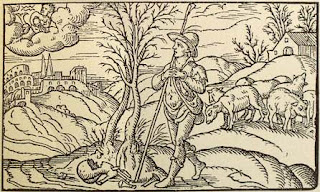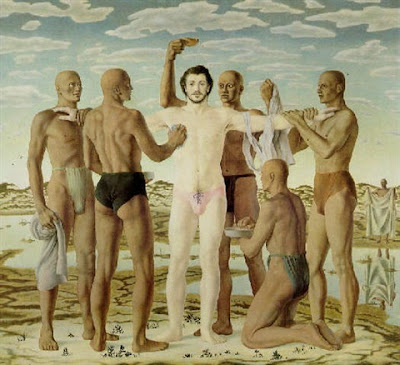Double Vision in Barnfield's Homoerotic Poetry (2)
Among
the London poets of the 1590s, pastoral epithets were established and shared:
Spenser as Colin, Drayton as Rowland, and Barnfield as Daphnis. Leo Daugherty
has argued convincingly that the Ganymede spoken of by Barnfield/Daphnis was
none other than William, Sixth Earl of Derby, who inherited the poetic title on
the death of his brother, Ferdinando (William Shakespeare, Richard Barnfield
and the Sixth Earl of Derby (p.13). The family’s heraldic crest bears an eagle
to connect them to the Ganymede myth. The Derby family were closely connected
to hermetical movements in the C16, most noticeably to Dr John Dee, who had
been the astrological and political advisor to Elizabeth I. Though Barnfield
dedicates Cynthia to William, saying “small is the gift”, he must have been
aware of how large was the connection. By linking Cynthia to the Sixth Earl, he
connects the book to Ganymede (his love) and hermetic political movements in
Elizabethan England—which is where the poetical vision begins.
“Cynthia”
is composed around an elaborate conceit that Peele had used in The Arraignment
of Paris (1584). At the close of his dramatic masque (performed in front of the
Queen), Majestie (Juno/Hera), Love (Venus/Aphrodite), Vertue (Minerva/Athene)
refuse the golden ball/orb of power and present the gift to Elizabeth. (In
Astraea, pp.63-4, Yates notes Barnfield’s imitation of this theme). This poetic
conceit was also visually present in a painting by Eworth (1569) hung at
Whitehall Palace. Elizabeth, as Paris, as three-in-one, a trinity harmonizing all of the goddesses, maintains the orb for herself.
Using
hermetical number symbolism, Stanzas 1-15 of “Cynthia”, form a ladder of ascent
(as in The Psalms) that culminate in a vision of the triple-formed Elizabeth,
the Spenserian Faerie Queene who possesses Power, Loveliness and Wisdom. Stanza
16 celebrates Elizabeth as the Sun and Stanza 17 as a “peerelesse Prince”.
Unlike the visual conceit of Eworth, Barnfield dwells on the androgynous nature
of Elizabeth who is both the Idea of physical pulchritude in woman and of
mental wisdom in men. Such is an orthodox Spenserian view (Britomart,
Belphoebe, and even Una in whom Sylvanus see his youthful male beloved, Cyparissus).
“Cynthia” is a vision of political order in the key of chastity. The twenty
sonnets that follow are homoerotic, but also in the key of Virgo. This is
introduced by the Latin emblem for the whole volume: Quod cupio, nequeo, “What
I desire, I cannot have.”
In
taking the pseudonym, Daphnis, Barnfield draws upon classical Greek myth. He is
the male laurel, Apollo’s tree, a shepherd son of Hermes, who offended Eros and
Aphrodite and was consequently cursed with unrequited love. He is the
homoerotic poet whose desire cannot be consummated. His Ganymede isn’t the
Ganymede of traditional mythologizing, but a beautiful boy, as Sonnet 9
explains, whom was created by Diana and Venus—a contained lover wholly “to
chastity inclinde.” The twenty sonnets place homoerotic desire in the context
of a world where they cannot be physically realised, yet, as Neo-Platonism
claimed, they allow for a poetic birth out of chastity (just as Elizabeth’s
reign as Gloriana was born from her chastity).
The twenty sonnets, as already, said parallel the twenty Spenserian Stanzas of Barnfield's Gloriana vision. They also consciously open where "Cynthia" closes: Beauty, Majestie and Virtue quarrel over who shall possess Ganymede. Beauty/Love/Venus demands his lips, his cheeks, his eyes and hair; Majesty/Hera requests his brow, chin, countenance and stature; Virtue asks only for his Modesty and wins. If Barnfield had been a cultured Neo-Platonist, he would have known, as Ficino and Bruno argued via the myth of The Judgement of Paris, that a trinity should not be split, but remain as a dynamic whole. Virtue triumphs in Sonnet 2 and in Sonnet 3, Barnfield dismisses Virtue in favour of Beauty/Love, for he wishes for "loues faire eie" alone (line 14). Sonnet 4 diverges further still from the trinitarian vision of "Cynthia" as Barnfield recognises that Ganymede, unlike Elizabeth, is a sun with night, so does not dwell in continual glory. The Barnfield sonnets progress towards a homoerotic love for Ganymede, under the guidance of one goddess, Venus.
The sensual core of the Sonnets commences with Sonnet 6. This has been described disparagingly as a wet-dream poem. Such a judgement is somewhat adolescent itself. This is a young poet writing within the conventions of his time, not a C20 confessional poet... Sonnet 6 describes the rejuvenating effect of sexual release. And Sonnet 7 recognises the beauty and fear contained within desire. Barnfield's swan on the Thames is stock imagery from Drayton's The Shepherd's Garland (1593), but there are some gentle, personal touches. Ganymede is a "pruned" lover, like a swan that has oiled its feathers with its beak, and his feathers/hairs are massaged and decorative-- the imagery runs beautifully into Neptune washing the lover's feet with splashes of water. An extreme modern reading by Charles explains Barnfield's fear, at this point, as one of "outing" ("Barnfield's Lovers Discourse", The Affectionate Shepherd, Celebrating Richard Barnfield, p.179). Thetis, being heterosexual, will divulge the gay love between Ganymede and Daphnis. There is little, however, within the text to support this modern interpretation. Barnfield states that he does not fear Neptune (even though he loved the boy Pelops, which is implied) nor Apollo who desired the boy Hyacinthus, nor Sylvanus who loved Cyparissus. They would understand his desire. His fear is Thetis and the currents of heterosexuality. Ganymede's love wounds like the spear of Achilles (Sonnet 5) and Achilles' mother could open up dangerous tributaries.
The sonnets are unswerving in their aim towards pleasure. They refuse to pull back into a refined, distant worship of Neo-Platonic Mind and Courtiership. The target is nature's "lips ripe strawberries in Nectar wet" (Sonnet 17). In making this choice, Daphnis must accept that he draws further away from the political context of "Cynthia". That distance is measured in Sonnet 15 (a climactic point, as in "Cynthia") where Barnfield notes that divine males loved boys and did not look down on pastoral swains whereas the Court and intellect are "infected" by pride. Chastity has become hard-heartedness. In sonnets 16 and 17, Barnfield focuses on the problematical nature of language in the Sonnets.
The “Ode” that follows the two sequences describes the death of Daphnis. Here, Barnfield's model is Theocritus' Idylls 1. An unknown speaker finds Daphnis weeping for his beloved. "Fancy" pulls Daphnis towards his boy love and "Love" pulls him towards a nymph. Consequently, he abandons Ganymede for a triple-formed Eliza (Beauty, Majesty and Wisdom). It is a surrender to Elizabethan times, one that requires he give up a fanciful desire for Ganymede (homoeroticism) for what love commands: heterosexuality. His acceptance of that Idea leads to a broken heart. Using the pastoral mirror of The Golden Age, the Daphnis poems, in Cynthia, are an exploration of same sex desire in Elizabethan England.
The twenty sonnets, as already, said parallel the twenty Spenserian Stanzas of Barnfield's Gloriana vision. They also consciously open where "Cynthia" closes: Beauty, Majestie and Virtue quarrel over who shall possess Ganymede. Beauty/Love/Venus demands his lips, his cheeks, his eyes and hair; Majesty/Hera requests his brow, chin, countenance and stature; Virtue asks only for his Modesty and wins. If Barnfield had been a cultured Neo-Platonist, he would have known, as Ficino and Bruno argued via the myth of The Judgement of Paris, that a trinity should not be split, but remain as a dynamic whole. Virtue triumphs in Sonnet 2 and in Sonnet 3, Barnfield dismisses Virtue in favour of Beauty/Love, for he wishes for "loues faire eie" alone (line 14). Sonnet 4 diverges further still from the trinitarian vision of "Cynthia" as Barnfield recognises that Ganymede, unlike Elizabeth, is a sun with night, so does not dwell in continual glory. The Barnfield sonnets progress towards a homoerotic love for Ganymede, under the guidance of one goddess, Venus.
The sensual core of the Sonnets commences with Sonnet 6. This has been described disparagingly as a wet-dream poem. Such a judgement is somewhat adolescent itself. This is a young poet writing within the conventions of his time, not a C20 confessional poet... Sonnet 6 describes the rejuvenating effect of sexual release. And Sonnet 7 recognises the beauty and fear contained within desire. Barnfield's swan on the Thames is stock imagery from Drayton's The Shepherd's Garland (1593), but there are some gentle, personal touches. Ganymede is a "pruned" lover, like a swan that has oiled its feathers with its beak, and his feathers/hairs are massaged and decorative-- the imagery runs beautifully into Neptune washing the lover's feet with splashes of water. An extreme modern reading by Charles explains Barnfield's fear, at this point, as one of "outing" ("Barnfield's Lovers Discourse", The Affectionate Shepherd, Celebrating Richard Barnfield, p.179). Thetis, being heterosexual, will divulge the gay love between Ganymede and Daphnis. There is little, however, within the text to support this modern interpretation. Barnfield states that he does not fear Neptune (even though he loved the boy Pelops, which is implied) nor Apollo who desired the boy Hyacinthus, nor Sylvanus who loved Cyparissus. They would understand his desire. His fear is Thetis and the currents of heterosexuality. Ganymede's love wounds like the spear of Achilles (Sonnet 5) and Achilles' mother could open up dangerous tributaries.
The sonnets are unswerving in their aim towards pleasure. They refuse to pull back into a refined, distant worship of Neo-Platonic Mind and Courtiership. The target is nature's "lips ripe strawberries in Nectar wet" (Sonnet 17). In making this choice, Daphnis must accept that he draws further away from the political context of "Cynthia". That distance is measured in Sonnet 15 (a climactic point, as in "Cynthia") where Barnfield notes that divine males loved boys and did not look down on pastoral swains whereas the Court and intellect are "infected" by pride. Chastity has become hard-heartedness. In sonnets 16 and 17, Barnfield focuses on the problematical nature of language in the Sonnets.
Weening to kisse his lips, as my loue's fee's (fees?)
I feel but Aire, but Aire to bee him.
Thus with Ixion, kisse I clouds in vaine.
Thus with Ixion, feele I endles pain.
(ll. 11-14)
Punning on "fees" as expenses and intercourse, Barnfield senses that his sexual metaphors are no more than deceptions--like the duped Ixion, he is left penetrating a cloud-shaped Hera/Majesty--and thus acquiring a life of "endles paine". Even so, in Sonnet 17, an alternative pleasure is imagined in which the beautiful body, exceeding Apollo and Adonis, might create a beautiful body of words to be loved. Eventually this to-and fro-ing comes to a point of exhaustion.
The “Ode” that follows the two sequences describes the death of Daphnis. Here, Barnfield's model is Theocritus' Idylls 1. An unknown speaker finds Daphnis weeping for his beloved. "Fancy" pulls Daphnis towards his boy love and "Love" pulls him towards a nymph. Consequently, he abandons Ganymede for a triple-formed Eliza (Beauty, Majesty and Wisdom). It is a surrender to Elizabethan times, one that requires he give up a fanciful desire for Ganymede (homoeroticism) for what love commands: heterosexuality. His acceptance of that Idea leads to a broken heart. Using the pastoral mirror of The Golden Age, the Daphnis poems, in Cynthia, are an exploration of same sex desire in Elizabethan England.





Comments